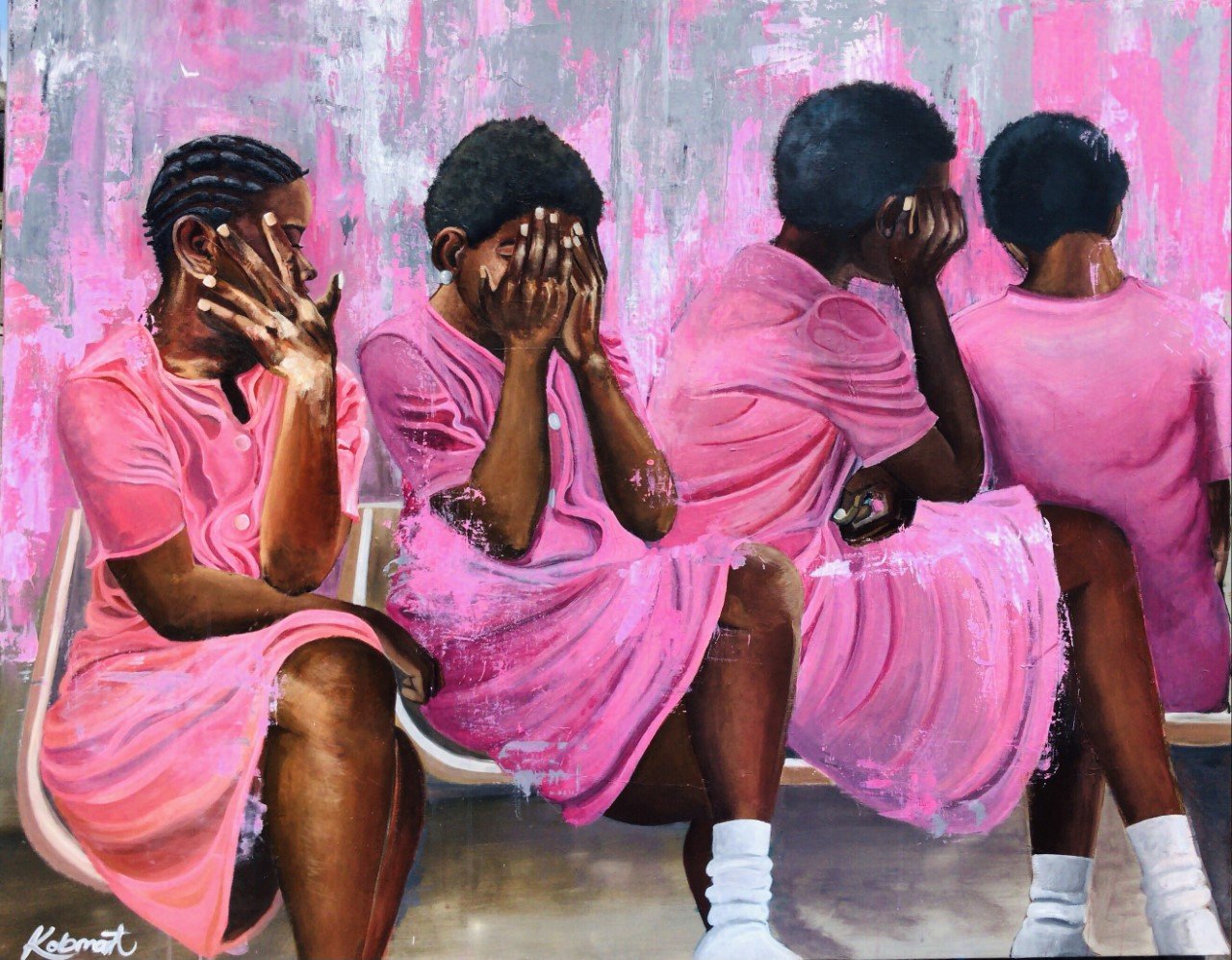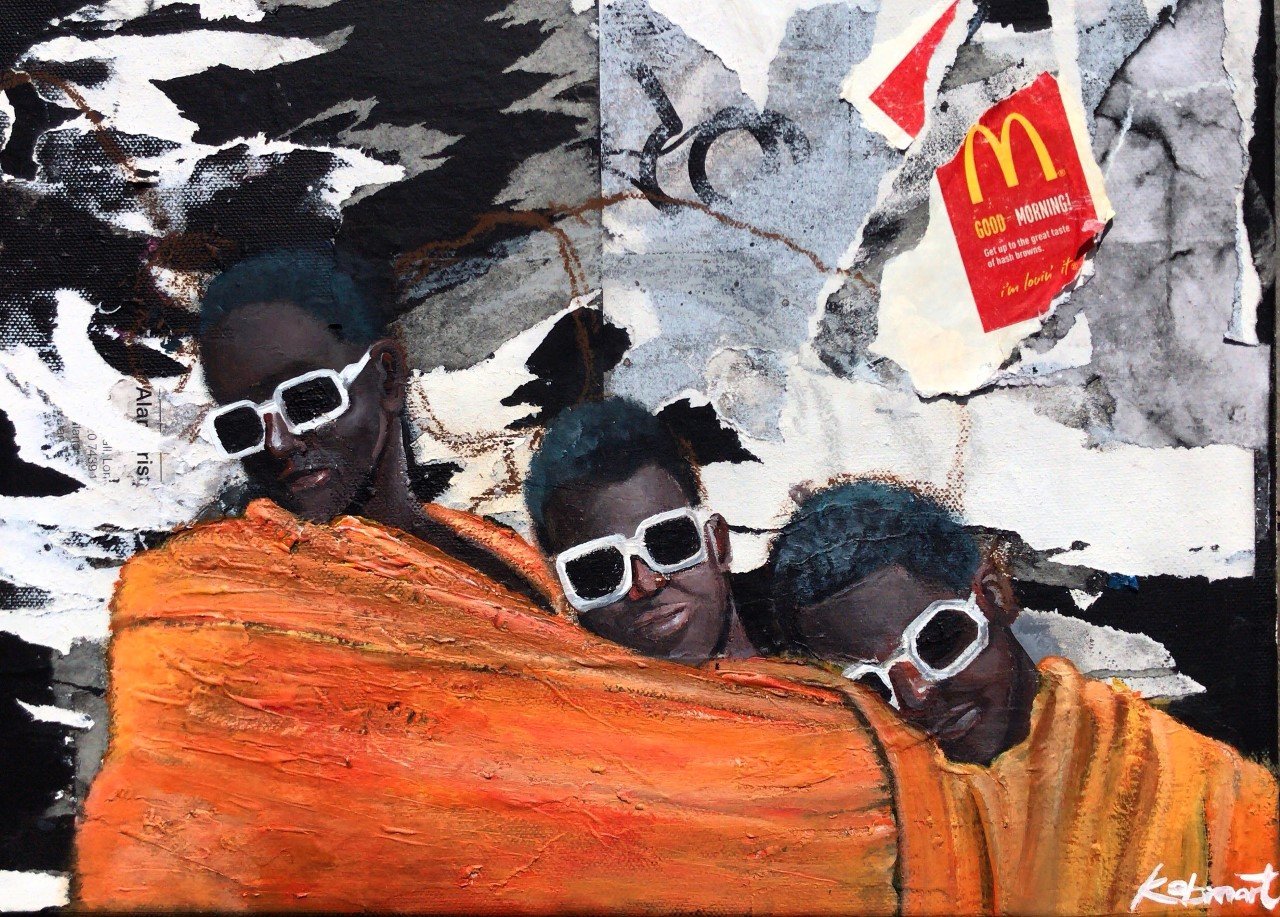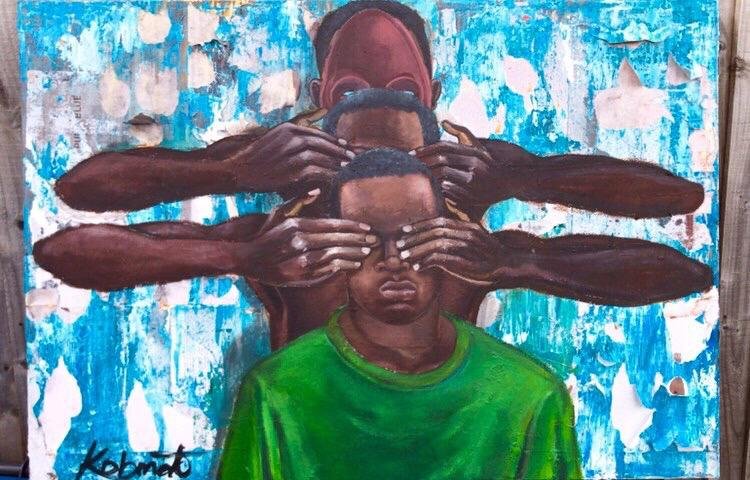Horcelie Sinda in Conversation with Artist Koby Martin
Ghanaian-born artist Koby Martin's work is an autobiographical tale of migration, identity, and faith in Christianity. London-based, he explores migration and African history as a juxtaposition of his Ghanian and British identities. Drawing from the symbolic Adinkra dynasty, he conveys traditional Ghanaian wisdom of the past and present through his work.
Koby Martin, 2021. Image courtesy of Brynley Davies.
Martin's multidisciplinary practice provokes questions about ‘placeness’ as a poet, performer, and entrepreneur while offering his perspective as a Black and African man. His portrayal of Black and African males is never silent, though it might appear more subdued in works such as those in his 2017 solo exhibition collection, Boy In The Field. The males depicted are courageous in form and strength, and these two attributes are conveyed, particularly in their eyes, consistently throughout the visual narrative. Martin’s heartfelt imagery in these dynamic images contribute to the global discussion of migration and highlights the complexity of it as an emotionally and politically charged experience.
Generally, memory is often fragmented and Martin intentionally positions the viewer in order for them to adopt a voyeuristic gaze. This perspective encourages viewers to recall, reflect, and examine the feelings of the past on such sensitive subjects. His techniques of displaying emotion are both eye-catching and transcendental on his canvases and in his films. He narrates and attests to the isolating experience of an immigrant within the surveillant society we live in. He ministers frightening tales about the notion of ‘placeness’ or the lack thereof and the difficulties of belonging throughout his body of work.
Koby Martin, Boy In The Field, 2017.
Horcelie Sinda: What interests you as an artist?
Koby Martin: I am interested in spaces; I mean, the walls that surround these spaces. As the saying goes, if these walls could talk, you would probably know everything in the room. I believe that walls are layered and I use this analogy for human beings as we are also layered with the mind, body, and soul. When you look at my work, there is much texture within the paintings. All these things come together when composing my work. I am also free to leave others to their interpretations of it.
HS: How do you find the art scene in the UK as a Ghanaian-British artist?
KM: The murder of George Floyd during lockdown was a massive and topical event felt by all Black people. His death felt like sacrifice so that our Black voices could be heard in different spaces, corporations, commercial settings, or other areas in the art industry. It is and has been interesting to see Black people in spaces they have not been in previously. As an artist, you have to reflect on the times we live in today.
HS: How do you utilise your social media as an artist?
KM: I didn’t post or share new work for a whole year because I was trying to get my visual language right. Moreover, I have not been to any shows because I do not want to do something for the sake of doing it. I am serious about things and I want to do things differently.
HS: Is there any literature that has inspired you as an artist?
KM: The Bible is poetry of God expressing himself and his love for us. It is a blueprint of life. My life has been influenced because of how God has directed it to be. The Bible is poetry and literature. It is life and it is not just written. For example, the story of Joseph is my favourite story because of the many concepts that come from it. Similar to the story of Jacob and how he wrestled with God.
HS: What has been happening in the Ghanaian art scene in recent years?
KM: I would say it is flourishing and I love what is happening in Ghana now. However, the government fails to understand the power of creativity and how it can transform the country through various opportunities. I went to Ghana in 2019 to work with the British Council and British High Commission for a discussion about highlighting practising artists. I was one of the panellists discussing and reinforcing the importance of continuing to be an artist today. While I was in Ghana I was able to experience other art mediums and be part of Afrochella, the African music festival.
HS: What exhibitions have you recently been involved in and are there any that you are taking part in this year?
KM: I am currently featured in a public exhibition with Tate Modern called Beyond Boundaries which is on view through May 2022. The experience was exhilarating and I have always wanted to work with Tate. To have my work shown within an institution such as the Tate was terrific. In the future, I would like to participate in group shows with Victoria Miro, Saatchi, Sotheby's, and Goodman Gallery. I am also working towards a solo exhibition.
Martin’s collaboration with the Tate Collective, Spot Light Dreams, will be on view through May 2022. The vibrant wall mural is located at St Felix Palace, 45 Southwark St, in Southeast London.
Thanks to Koby Martin on behalf of MADE IN BED.
All images are courtesy of Koby Martin and Brynley Davies.
For more information about Koby Martin, visit his website and follow him on Facebook, Twitter, and Instagram.
Horcelie Sinda
Contributing Writer, MADE IN BED









